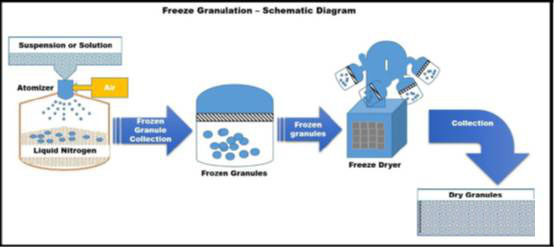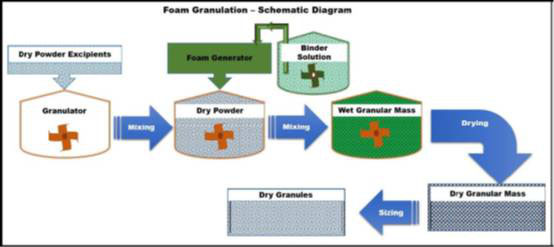Latest Granulation Techniques and Technologies IV
Writer: admin Time:2021-01-26 16:08 Browse:℃
1. Frozen granulation

Frozen granulation refers to the technique in which solution or suspension is sprayed into liquid nitrogen. The liquid drops are then frozen and dried. More particularly, after being sprayed into liquid nitrogen, the suspension will immediately be frozen to granules. In the later frozen drying, the moisture can be removed by subliming. Based on water or organic solvent, frozen granulating technique can be applied to produce spherical granules with good fluidity. One of the advantages of this technique is to keep the structure and uniformity of API. Although this technique can be used to process all kinds of materials, it can generate higher efficiency when it is used to granulate the mixture of fine powder and proper adhesives. The products’ uniformity can be improved.
The end granules can have proper size and uniformity. The parenteral preparation, nanometer preparation and solid self-emulsifying drugs can all be produced by this technique to keep the granule size and uniformity constant. In fact, the uniformity of suspension can determine and reflect the uniformity of granules. Frozen drying and granulating can protect organic material from being damaged so as to improve drugs’ stability and dissolution.
Compared with spraying drying, frozen granulation can produce protein granules with light weight, more pores and excellent aerosol performance.
In addition, this granulation technique also have other advantages. First of all, the granule density can be controlled by controlling suspension concentration to produce granules without pores. Secondly, granules are of high uniformity because of no migration of fine granule or adhesive. Thirdly, moderate drying can help granulation of heat-sensitive material. Fourthly, the product output rate is pretty high. Last but not least, the organic solvent can be recycled.
Organic solvent with freezing point ranging from -25°C to 10°C can be used. But water is still the first choice for frozen granulation. Therefore, this technique might be restricted in granulating API and excipients with poor solubility. The frozen granulating technique was firstly invented by Swedish Ceramic Society and now developed by powderpro AB.
2. Foam granulation

Foam granulation, or foam adhesive granulating technique, is similar to spraying and agglomeration granulation. During production, adhesive is fed in the shape of foam, instead of being sprayed or poured.
In 2003, foam adhesive was firstly used in high shear granulation and fluid-bed granulation. The foam generator is installed in the adhesive tank of high shear granulator or fluid-bed granulator. Then adhesive can be fed in form of foam, which can eliminate the influence of non-uniform distribution of adhesive on tablet hardness and drug release.
This technique makes use of the principle that the surface and volume of foam adhesive are both larger than that of spraying adhesive so that adhesive distribution on powder and granules is improved. As a result, the used adhesive is less than that in regular spraying wet granulation.
Besides, the sprayed drops have low diffusion-permeability ratio, which means that drops will permeate into powder, rather than diffusing on granule surface. Therefore, spraying wet granulation needs more adhesive and another step to remove redundant moisture. On the other hand, the ratio of foam adhesive is higher. The adhesive only distributes on granule surface but will not permeated inside the granules. As a result, less adhesive will be used. Foam granulation improves reproducibility and shortens time of granulation. More importantly, foam granulation solves problems of sprayer clogging and other related variants.
Except the above advantages, the uniform distribution of adhesive can be advantageous to mixing API with low dosage or high activity. In addition, moisture-sensitive medicine (except rapid-release or controlled-release preparations) can also be processed by this technique due to its low dosage of adhesive and short granulating time. The standard wet granulating machine, including high/low shear granulator, fluid-bed granulating machine, and so on, can be used for foam granulation in that another foam generator is set. However, the foam quality, technical parameters, equipment and foam fluidity should be all further experimented. Besides, regulation and approval will be huge obstacles for foam granulation.
Conclusion
Technical innovation can improve and simplify current granulation and upgrade product quality, although it affects developing process, time and economic yield. Granulating technologies and techniques have been obviously bettered in the past few years. High-efficiency granulating techniques always attract pharmaceutical industry, which then pushes scientists to study and develop new techniques. Preparation researchers must take medicine properties into account during preparation development. Every granulating technique has its own advantages and disadvantages. Except granulating technologies and techniques, medical physical and chemical properties, excipients, target granule fluidity and release properties should all be considered. This passage is only an overview on latest development of common granulating techniques. But for oral disintegrating tablets, these passage is not applicable. On the other hand, there are still some problems of production efficiency, yield and management. Therefore, only a few granulating techniques have been applied in practical production. The techniques introduced in this passage can be further developed.

